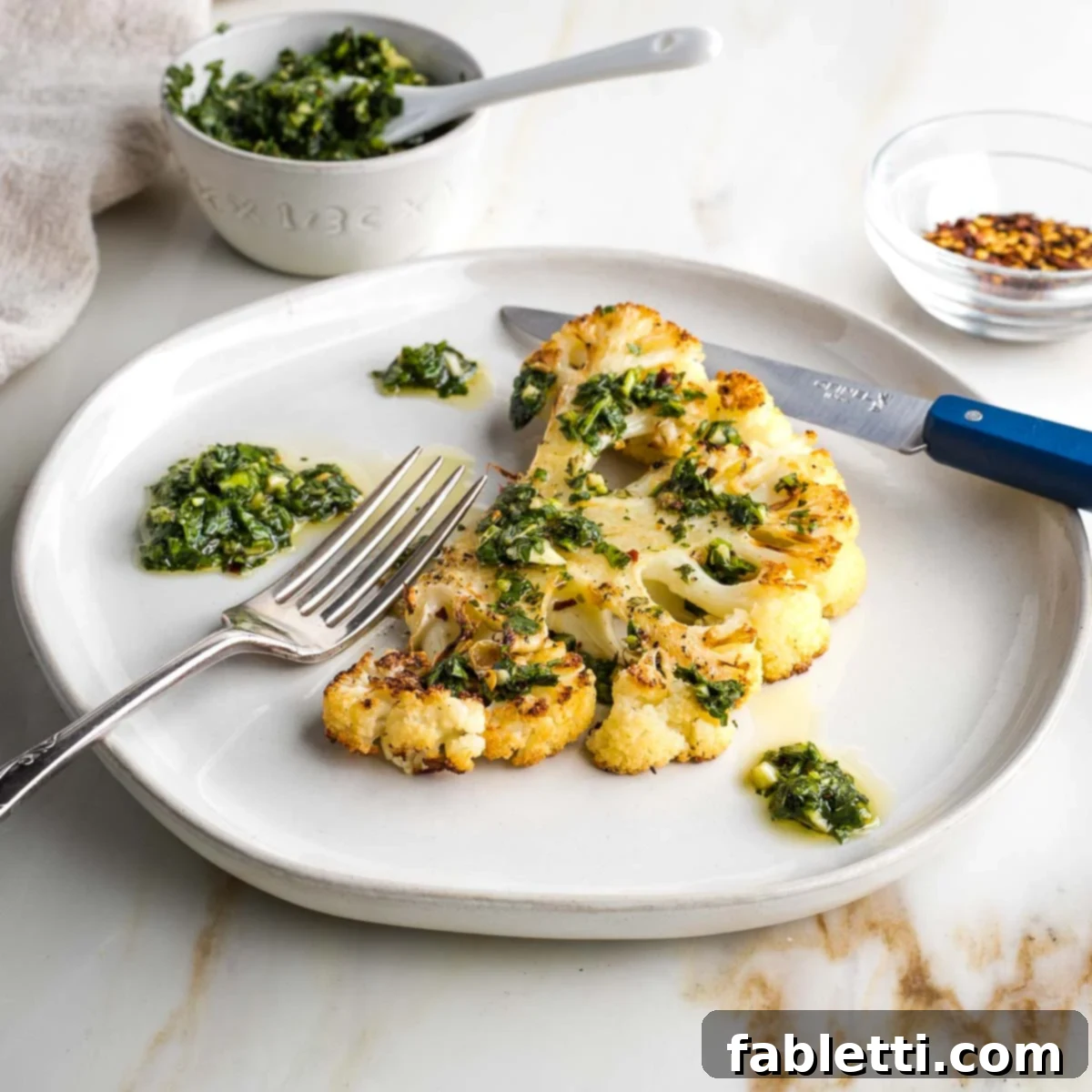Step into a world of vibrant flavors and satisfying textures with this incredible vegan cauliflower steak recipe, generously smothered in a zesty homemade chimichurri sauce. It’s a dish that consistently wows, whether it’s a quick weeknight dinner or the show-stopping centerpiece of an elegant gathering. Thick, succulent slices of cauliflower are roasted to a tender, golden-brown perfection, offering a hearty plant-based alternative that truly satisfies. The secret to its irresistible appeal lies in the fresh, bright, and herbaceous chimichurri sauce – an explosion of flavor that beautifully balances the mild sweetness and robust texture of the roasted cauliflower. Easy to prepare and bursting with wholesome goodness, this recipe is a testament to how simple ingredients can transform into something extraordinary.

This post has been updated from the original dated March 12, 2018, bringing you even more tips and culinary insights.
Table of Contents
- Why You’ll Love Cauliflower Steaks
- Why This Vegan Recipe is a Must-Try
- Essential Cauliflower Steak Ingredients
- Sauce Pairings for Cauliflower Steaks
- Understanding Chimichurri: The Flavorful Argentinian Sauce
- Chimichurri Sauce Ingredients
- How to Perfectly Cut Cauliflower for Steaks
- Mastering Oven-Roasted Cauliflower Steaks
- Crafting Your Homemade Chimichurri Sauce
- Expert Tips for Cauliflower Steak Success
- Storage and Reheating Best Practices
- More Delightful Cauliflower Recipes
- The Full Recipe
If you’re new to the world of vegan cauliflower steaks, prepare for an absolutely delightful and deeply satisfying plant-based experience! This dish transcends typical vegetable sides, offering a hearty and substantial main course that will leave you feeling full and happy. The roasted cauliflower develops an incredible depth of flavor and a wonderfully tender texture, while the vibrant chimichurri sauce injects a bright, zesty, and tangy kick that perfectly elevates every bite. It’s a culinary revelation that proves plant-based eating can be both simple and exceptionally flavorful.
Why You’ll Love Cauliflower Steaks
Transforming a humble head of cauliflower into elegant, oven-roasted steaks is not just a trend; it’s a brilliant way to enjoy this remarkably versatile vegetable. Cauliflower, often celebrated for its mild flavor and adaptability, takes on a whole new dimension when sliced thick and roasted. The high heat coaxes out its natural sweetness, creating a tender interior and beautifully caramelized, slightly crispy edges that are simply irresistible. Beyond steaks, cauliflower shines in countless preparations. I frequently turn to it for a comforting whole roasted herb-rubbed cauliflower, a versatile simple cauliflower rice, or as a lighter substitute for potatoes in a creamy leek soup. It’s also fantastic raw in a crisp raw cauliflower salad, or baked into a savory cauliflower kugel that is truly heavenly. This recipe further highlights cauliflower’s potential to be both wholesome and incredibly exciting.
Exploring more Healthy Passover Recipes? This vegan cauliflower steak with chimichurri is an excellent choice! Discover fresh and exciting Vegetarian and Vegan Recipes for Passover that perfectly align with your balanced diet and holiday traditions.
Why This Vegan Cauliflower Steak Recipe is a Must-Try
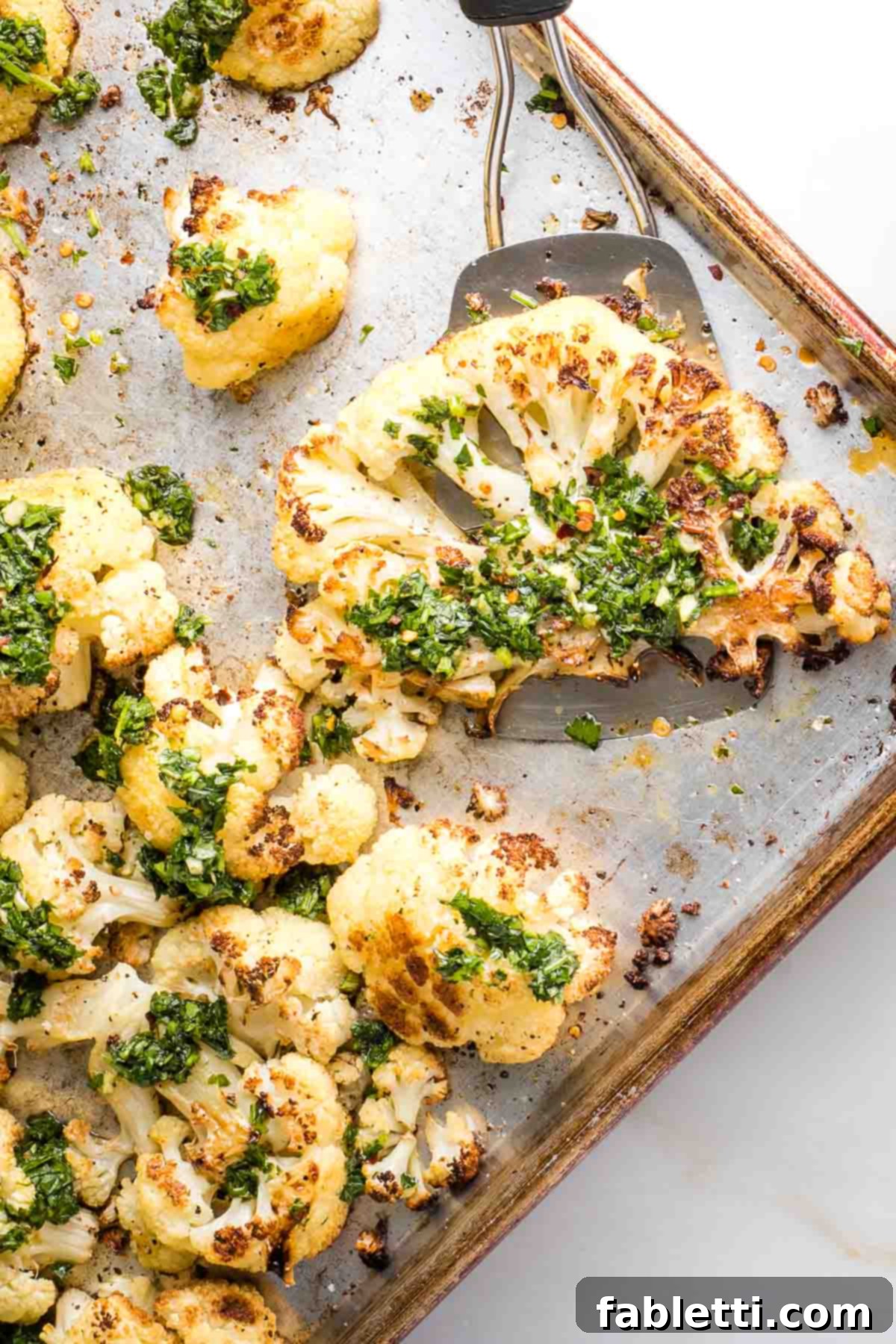
- Unbeatably Delicious and Satisfying: When it comes to plant-based main courses, this vegan cauliflower steak stands out. It’s not only incredibly wholesome and hearty but also packed with flavor, making it a truly satisfying meal that even meat-eaters will adore.
- Bursting with Fresh Herb Flavor: The secret to this dish’s vibrant taste lies in the fresh herbs used in the chimichurri. They provide a bright, aromatic, and incredibly tasty way to infuse your meals with natural goodness and dynamic flavor.
- Versatile Serving Options: Whether you serve it as an impressive main course, perhaps sprinkled with some chopped nuts for added crunch, or as a flavorful side dish alongside your favorite proteins, this cauliflower steak fits perfectly into any meal plan.
- The Ultimate Cauliflower Steak Sauce: Chimichurri isn’t just a sauce; it’s a flavor enhancer that makes these cauliflower steaks truly special. Its tangy and herbaceous profile is unparalleled. However, if chimichurri isn’t your preference, a rich and savory vegan gravy makes an excellent alternative to spoon over your crispy cauliflower.
- Effortless Preparation and Cleanup: This recipe simplifies cooking with minimal ingredients and the convenience of a single baking tray. It’s designed for ease, making both meal prep and post-dinner cleanup a breeze.
- A Wholesome and Healthy Choice: Enjoy a meal that’s naturally low in calories but rich in essential fiber, vitamins, and minerals. Cauliflower is a nutritional powerhouse, making this dish a smart choice for a balanced diet.
- Perfect for Passover and Beyond: As a Kosher for Passover Vegan Main Dish, this recipe requires absolutely no substitutions. It’s perfect as is, making it an ideal, worry-free option for holiday meals or any time of year.
Essential Cauliflower Steak Ingredients

- Cauliflower: The star of our dish! Opt for a large, firm head of cauliflower to yield the thickest, most substantial “steaks.” Its size will directly influence the thickness and number of slices you can achieve.
- Olive oil: A crucial element for achieving those coveted crispy edges and a beautiful golden-brown caramelization. A thin, even coating ensures even roasting and enhances the cauliflower’s flavor.
- Salt and Black Pepper: These fundamental seasonings bring out the natural flavors of the cauliflower. For those on a low-sodium diet, consider omitting the salt or replacing it with a salt-free seasoning blend like Mrs. Dash. Freshly ground black pepper adds a subtle, warm flavor without overpowering spice.
Delightful Sauce Pairings for Cauliflower Steaks
While chimichurri is undoubtedly a perfect match, cauliflower steaks are incredibly versatile and can be paired with a variety of sauces to suit your taste or occasion. Here are some other fantastic options:
- Chimichurri: Our preferred choice for its vibrant, herbaceous, and tangy profile that cuts through the richness of the roasted cauliflower.
- Vegan Gravy: For a comforting and hearty meal, a rich vegan gravy adds a luscious, savory depth, making your cauliflower steak feel even more substantial.
- Green Tahini Sauce: A creamy, nutty, and slightly tangy tahini sauce provides a Mediterranean twist, offering a refreshing counterpoint to the roasted flavors.
- Romesco Sauce: A Spanish classic, romesco sauce (typically made with roasted red peppers, nuts, and garlic) offers a smoky, sweet, and tangy flavor. Use my basic oil-free romesco dip recipe and simply thin it out with a little olive oil or water to achieve a pourable consistency perfect for drizzling.
Understanding Chimichurri: The Flavorful Argentinian Sauce
Chimichurri is far more than just a sauce; it’s a vibrant, herbaceous condiment and marinade with deep roots in Argentinian and Uruguayan culinary traditions. Known for its ability to brighten any dish, chimichurri adds a unique zesty and tangy dimension that is both refreshing and complex.
- Traditional Composition: At its heart, chimichurri is crafted from a simple yet powerful blend of finely chopped fresh parsley, pungent garlic, a hint of spicy red pepper flakes, aromatic oregano, and a tangy combination of vinegar and olive oil.
- Versatile Variations: While the classic recipe is outstanding, many variations exist. Some chefs incorporate fresh cilantro for an added layer of freshness, lemon juice for extra brightness, or other herbs and spices to customize the flavor profile.
- Beyond Traditional Steaks: Though famously served as a condiment for traditional grilled meats and steak in South America, chimichurri is incredibly versatile. It harmonizes exceptionally well with vegan steak recipes like our cauliflower steaks, and it’s also a fantastic addition to salads, sandwiches, and grain bowls.
- Creative Uses: Don’t limit chimichurri to just main courses! It makes an excellent dipping sauce for crispy sweet potato fries or savory tofu satay, adding an instant burst of gourmet flavor to any snack.
Crafting Your Chimichurri: Key Ingredients

- Fresh Parsley: The heart and soul of this vibrant sauce. Fresh flat-leaf parsley offers a clean, herbaceous base. If you’re feeling adventurous, fresh cilantro can be a wonderful substitute for a slightly different, yet equally delicious, flavor.
- Oregano: Adds a distinct earthy and slightly peppery note. For a twist, you can substitute with fresh thyme or basil, adjusting the quantities to taste as these herbs can be more potent.
- Red Wine Vinegar: Provides the essential tangy acidity that brightens the sauce and balances the richness of the oil and herbs. White wine vinegar, fresh lemon juice, or even apple cider vinegar can be used as alternatives, each imparting a slightly different nuanced flavor.
- Olive oil: A good quality extra virgin olive oil forms the base of the sauce, helping to emulsify the ingredients and carry the flavors. For an oil-free chimichurri, consider using additional lime juice or a splash of water, though the texture and richness will differ.
- Garlic: Delivers a foundational pungent flavor. If raw garlic tends to upset your stomach, a clever trick is to roast the garlic cloves (skins on) alongside the cauliflower on the baking tray until tender. Peel and chop them before adding to the sauce. Alternatively, ½ teaspoon of garlic powder can be used in a pinch.
- Salt and Red Pepper Flakes: Salt enhances all the flavors, while red pepper flakes provide that signature spicy kick. Feel free to adjust the amount of red pepper flakes to your heat preference, or swap them for white pepper for a milder warmth.
How to Perfectly Cut Cauliflower for Steaks
Achieving beautifully intact cauliflower steaks starts with the right cutting technique. Precision ensures your steaks hold together during roasting. Preheat your oven to 425 degrees Fahrenheit (220°C). For the best and safest results, always use a sharp chef’s knife and a stable wooden cutting board.
First, begin by trimming off the very bottom of the cauliflower head and removing all of the thick outer green leaves. This creates a flat, stable base. Rinse the cauliflower under cool water and thoroughly pat it dry with a clean towel to ensure proper browning during roasting.

Next, place the prepared cauliflower head flat on its newly cut bottom on the cutting board. Carefully cut through the center, vertically, to halve the cauliflower. While you can remove any remaining small leaves, it’s crucial to leave the core of the cauliflower intact. The core acts as a natural binder, holding the individual florets together to form cohesive “steaks.”

Now, take each half and slice it into thick, approximately ½-inch to ¾-inch slices. The number of solid “steaks” you get will depend on the size of your cauliflower head. Typically, you can yield 2-3 thick, stable slices from the center of each half. The outer slices may naturally break into smaller florets, and that’s perfectly fine! These florets are equally delicious when roasted and can be arranged around your steaks on the baking sheet to minimize waste and maximize flavor.
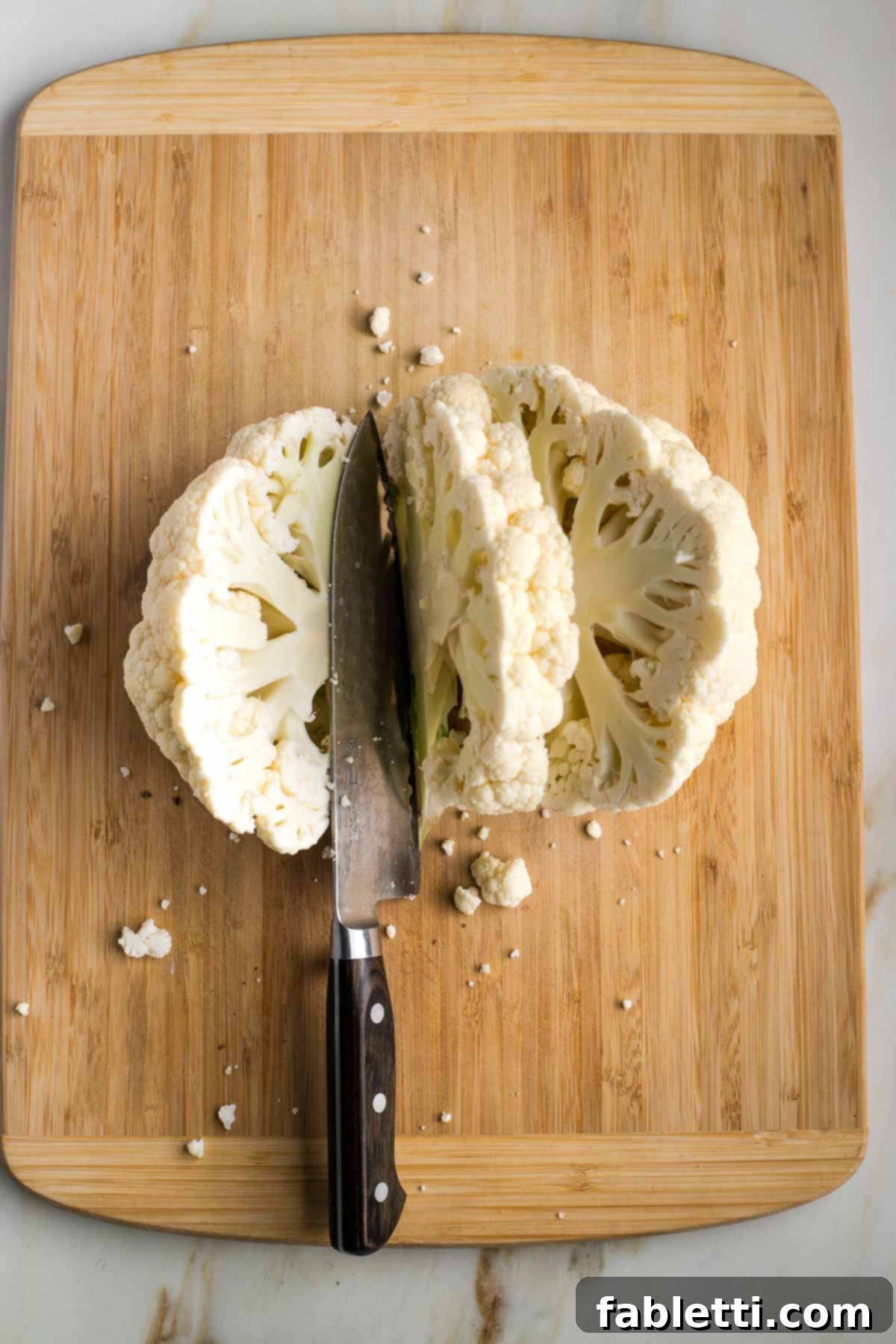
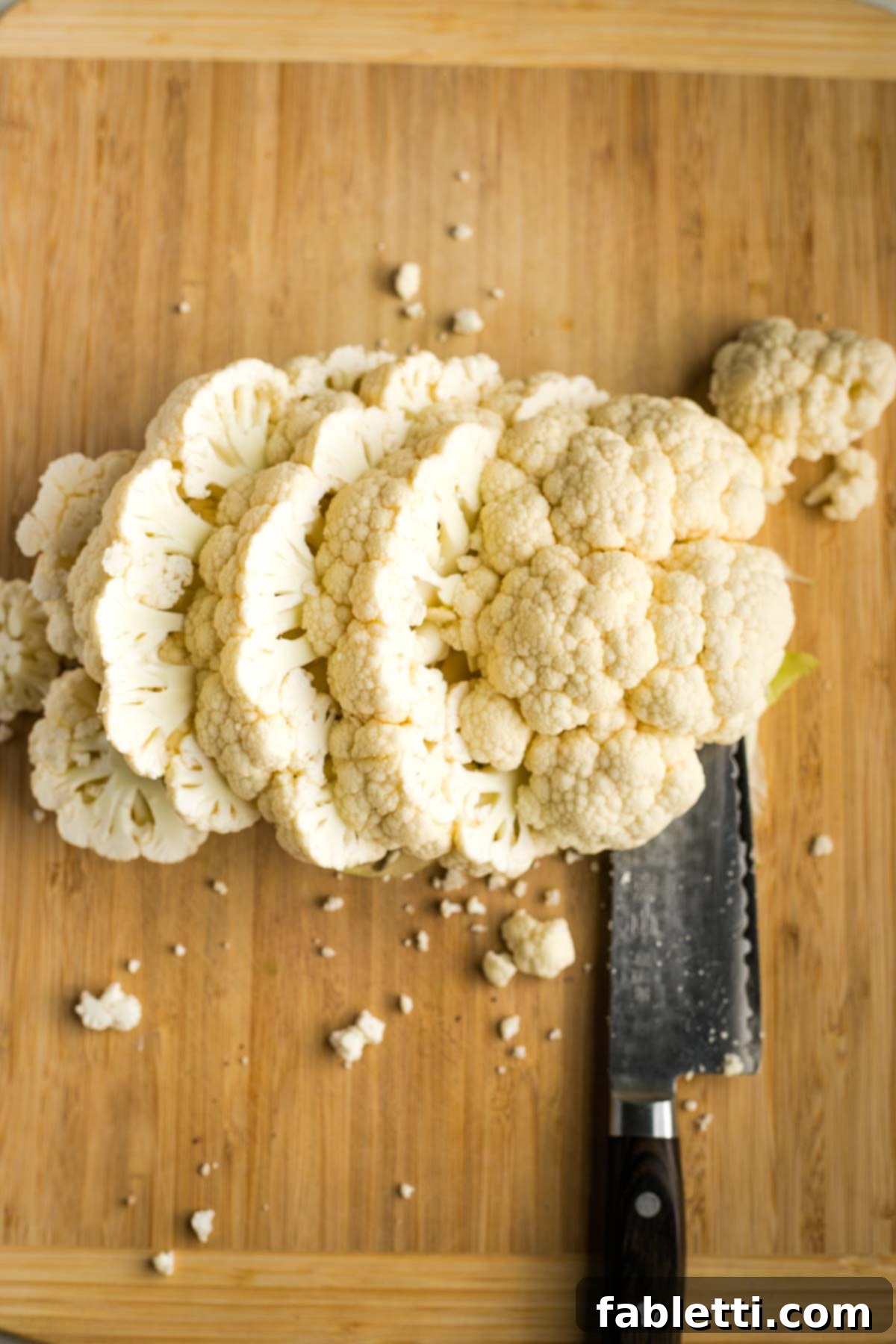
Mastering Oven-Roasted Cauliflower Steaks
Roasting is the ideal method to bring out the best in your cauliflower steaks, transforming them from simple vegetable slices into savory, golden-brown delights. Begin by arranging your carefully cut cauliflower steaks in a single layer on a large, rimmed baking sheet. Ensure there’s enough space around each piece for even cooking and optimal caramelization. Don’t discard the smaller florets that broke off during slicing; nestle them into any open spaces on the baking sheet. They’ll roast beautifully and add extra deliciousness to your dish.
Next, lightly brush a thin, even layer of olive oil over the surface of all the cauliflower pieces. This coating is essential for achieving those wonderfully crispy edges and a rich, golden hue. Once oiled, sprinkle generously with sea salt and freshly ground black pepper. These simple seasonings enhance the cauliflower’s natural flavors, creating a robust and savory profile.
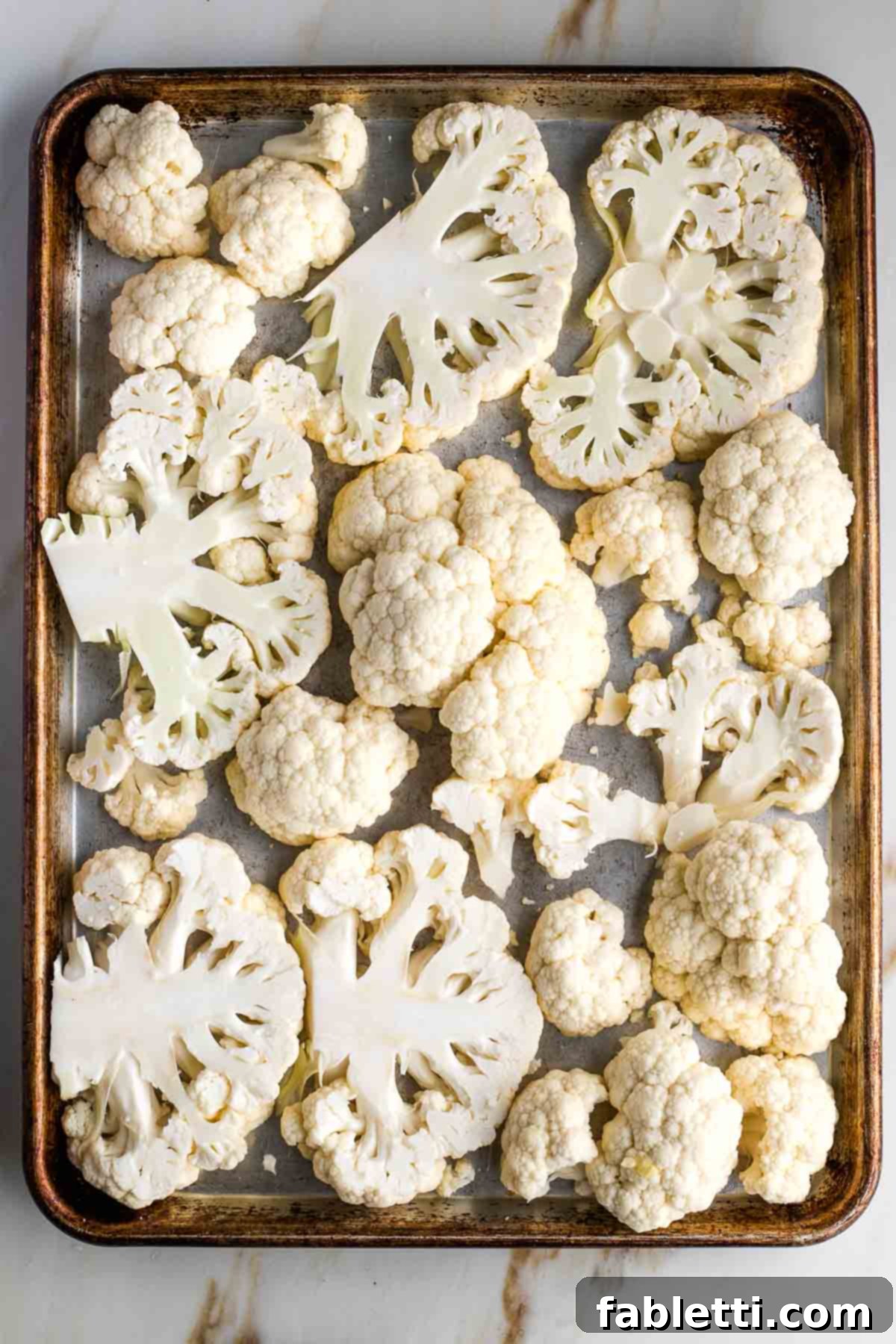

Place the baking sheet onto the middle rack of your preheated 425°F (220°C) oven. Roast for an initial 20 minutes, allowing the cauliflower to begin tenderizing and developing flavor. After this time, carefully flip each cauliflower steak and rearrange the florets to ensure even cooking. Return the tray to the oven and roast for an additional 10-15 minutes, or until the cauliflower is fork-tender and beautifully golden brown with slightly crispy edges. The exact time may vary slightly depending on your oven and the thickness of your steaks.

While your cauliflower is roasting to perfection, this is the ideal time to prepare your vibrant chimichurri sauce. This ensures it’s fresh and ready to enhance your hot-from-the-oven steaks.
Crafting Your Homemade Chimichurri Sauce
Making fresh chimichurri is surprisingly simple, and the result is a bright, herbaceous sauce that instantly elevates any dish. You have two main options for preparation: using a food processor for speed and convenience, or finely chopping everything by hand for a slightly coarser, rustic texture. Either way, your chimichurri sauce will be bursting with vibrant flavor and aroma.
If using a food processor, combine the fresh parsley, oregano, peeled garlic cloves, salt, and red pepper flakes in the bowl. Pulse the ingredients a few times until everything is finely minced but not pureed. Be careful not to over-process; you want a textured sauce, not a paste.

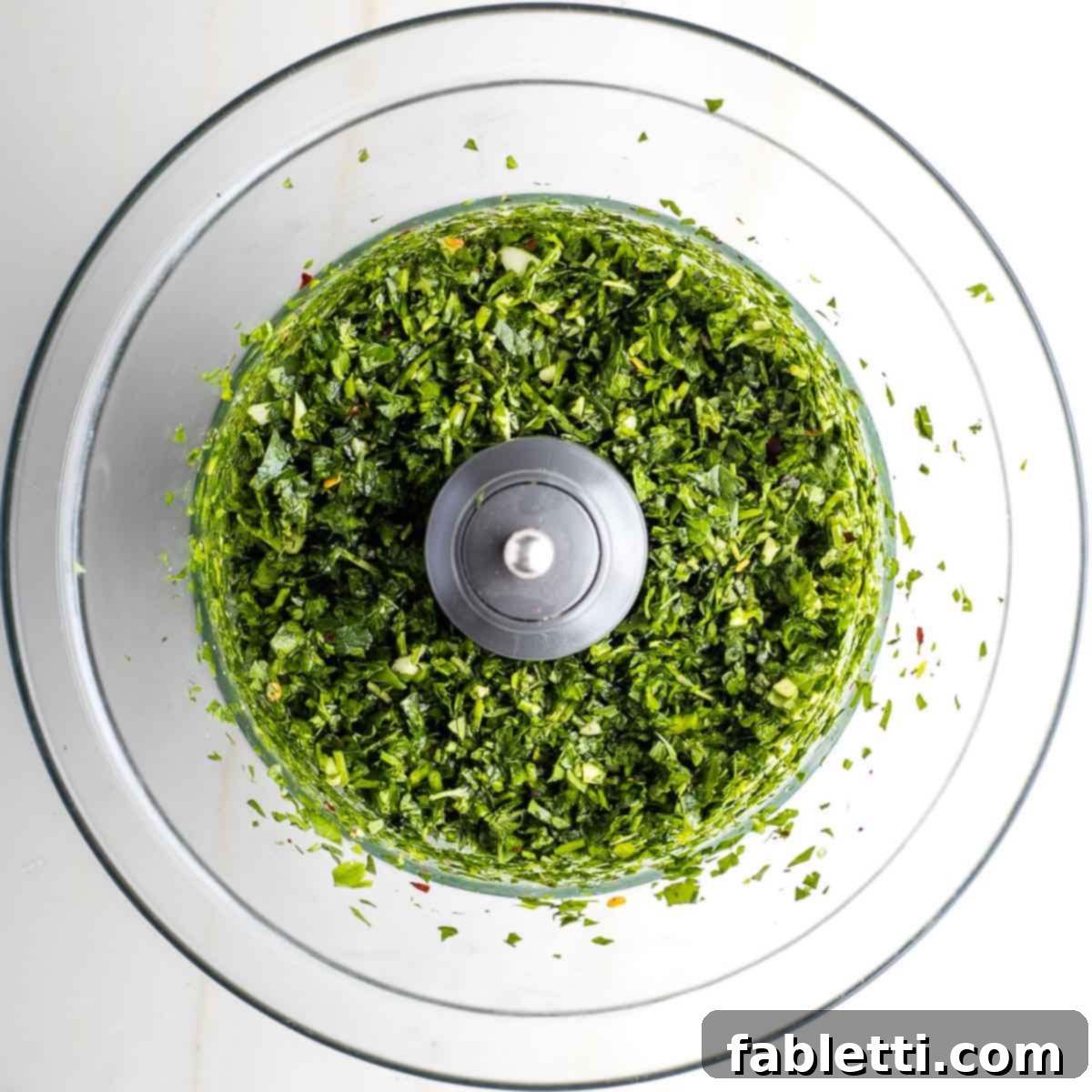
Once finely chopped, transfer the herb mixture to a small mixing bowl. Pour in the red wine vinegar and olive oil, stirring well to combine all the ingredients. Taste and adjust the seasoning as needed, adding more salt, pepper, or a pinch more red pepper flakes if you desire extra heat. The sauce should be bright, tangy, and richly herbaceous.

Once your perfectly roasted cauliflower steaks are ready, artfully spoon a generous amount of the freshly made chimichurri sauce over them. For those who love extra flavor, pass the remaining sauce around the table, allowing everyone to help themselves to more of this exquisite topping. Serve warm or at room temperature, and watch this vibrant dish disappear!


Debra’s Pro Tips for Cauliflower Steak Success

- Reheating Leftovers: The Cast Iron Secret: Don’t just microwave your leftover cauliflower steaks! Reheat them in a cast iron skillet with a drizzle of olive oil and a handful of thinly sliced Tuscan kale. Sauté until the steaks are re-crisped and the kale is tender-crisp. Trust me, this simple trick will elevate your leftovers to an entirely new level of deliciousness – you’ll be as obsessed as I am!
- Grilled Cauliflower Steaks: A Summer Delight: For a smoky twist, these cauliflower steaks are fantastic on the grill. Simply follow the basic recipe for cutting and oiling the steaks, then place them on a preheated grill over medium-high heat for about 5 minutes per side, or until tender with beautiful grill marks. The char adds another layer of irresistible flavor.
- Small Cauliflower? No Problem!: If your cauliflower head is on the smaller side, you might only get 1-2 solid steaks. That’s perfectly alright! The remaining florets will roast up just as beautifully and taste equally amazing. Arrange all the roasted cauliflower (steaks and florets) together on a large platter with plenty of chimichurri. Nobody will be any the wiser, and everyone will simply enjoy the deliciousness!
- Spice it Up: Feel free to customize your chimichurri! Add a pinch more red pepper flakes for extra heat, or include a finely minced shallot for a subtle oniony bite. A squeeze of fresh lime juice can also add an extra layer of brightness.
- Don’t Overcrowd the Pan: For perfectly roasted cauliflower with crispy edges, it’s crucial not to overcrowd your baking sheet. If you have too many pieces, use two sheets and rotate them halfway through cooking to ensure even browning.
Storage and Reheating Best Practices
Proper storage and reheating are key to enjoying your cauliflower steaks and chimichurri at their best. Follow these tips to maintain their deliciousness:
- Storing Cauliflower Steaks: Once cooled completely, transfer any leftover roasted cauliflower steaks to an airtight container. They will keep well in the refrigerator for up to 5 days, making them perfect for meal prep.
- Storing Chimichurri Sauce: The chimichurri sauce is best stored separately. Pour it into a covered jar or airtight container and refrigerate. It will remain fresh and flavorful for up to 10 days, allowing you to enjoy it with other meals too.
- Reheating Leftover Cauliflower Steaks: To bring your cauliflower steaks back to life, avoid the microwave if you want to retain their texture. For optimal crispness, reheat them in a preheated 425°F (220°C) oven for about 10 minutes, or until heated through and re-crisped. Alternatively, heat a large frying pan over medium-high heat, add the steaks, and cook for about 3 minutes per side until warmed through and slightly caramelized.
- Freezing Cauliflower Steaks: I generally do not recommend freezing roasted cauliflower steaks. The freezing and thawing process tends to make them mushy and compromises their desirable texture. It’s best to enjoy them fresh or within a few days of refrigeration.
More Delightful Cauliflower Recipes to Explore
If you’ve fallen in love with the versatility of cauliflower, there’s a whole world of delicious recipes waiting for you. Here are some of my other favorite ways to enjoy this incredible vegetable:
- Roasted Cauliflower Hummus Recipe
- Cauliflower Onion Rolls
- Vegan Cauliflower Soup with Red Lentils
- Cauliflower Rice with Asparagus
Did you enjoy this recipe? Your feedback means the world! Please consider leaving a five-star rating and a comment below to share your experience. And if you snap a picture of your delicious creation, remember to share it on Instagram by tagging me @dkhealthcoach and using the hashtag #debraklein. I’d love to see your culinary masterpieces!
📖 The Full Recipe

Vegan Cauliflower Steak with Chimichurri Sauce
Rate this Recipe
Pin Recipe
Equipment
- Food Processor
- Large Rimmed Baking Sheet
- Pastry Brush
Ingredients
- 2 heads cauliflower
- 1 ½ cups fresh parsley
- ½ cup fresh oregano
- 4 cloves garlic
- ½ teaspoon red pepper flakes
- ¼ teaspoon sea salt
- ¼ cup red wine vinegar
- ¼ cup olive oil
Instructions
- Preheat oven to 425°F (220°C).
- Prepare Chimichurri: In the bowl of a food processor (or by hand), combine fresh parsley, oregano, peeled garlic cloves, salt, and red pepper flakes. Pulse until finely minced. Transfer to a small bowl and stir in the red wine vinegar and olive oil until well combined. Taste and adjust seasoning as desired.
- Cut Cauliflower Steaks: Trim off the bottom and outer leaves from the cauliflower heads. Place each head flat on its cut bottom. Cut each head in half vertically through the core. Then, slice each half into ½ to ¾-inch thick steaks, ensuring the core remains intact to hold them together. Reserve any small florets.
- Roast Cauliflower: Lay the cauliflower steaks and florets in a single layer on a large rimmed baking sheet. Brush both sides of the cauliflower generously with olive oil, then sprinkle with salt and pepper. Roast in the preheated oven for 20 minutes. Flip the steaks and florets, then roast for another 10-15 minutes, or until golden brown and tender.
- Serve: Drizzle the roasted cauliflower steaks with a generous amount of fresh chimichurri sauce. Serve warm or at room temperature, passing any extra sauce around for guests to add more to their liking.
Notes
Nutrition
Carbohydrates: 20g
Protein: 7g
Fat: 16g
Saturated Fat: 3g
Polyunsaturated Fat: 2g
Monounsaturated Fat: 11g
Sodium: 251mg
Potassium: 1071mg
Fiber: 9g
Sugar: 6g
Vitamin A: 2072IU
Vitamin C: 169mg
Calcium: 192mg
Iron: 5mg
Note
The nutrition calculations provided are estimates based on online tools and the ingredients listed. For the most accurate nutritional information, especially if you have specific dietary needs, it is recommended to calculate the values using the precise ingredients and quantities you use. You are ultimately responsible for verifying the accuracy and completeness of any nutritional data for your specific circumstances.
